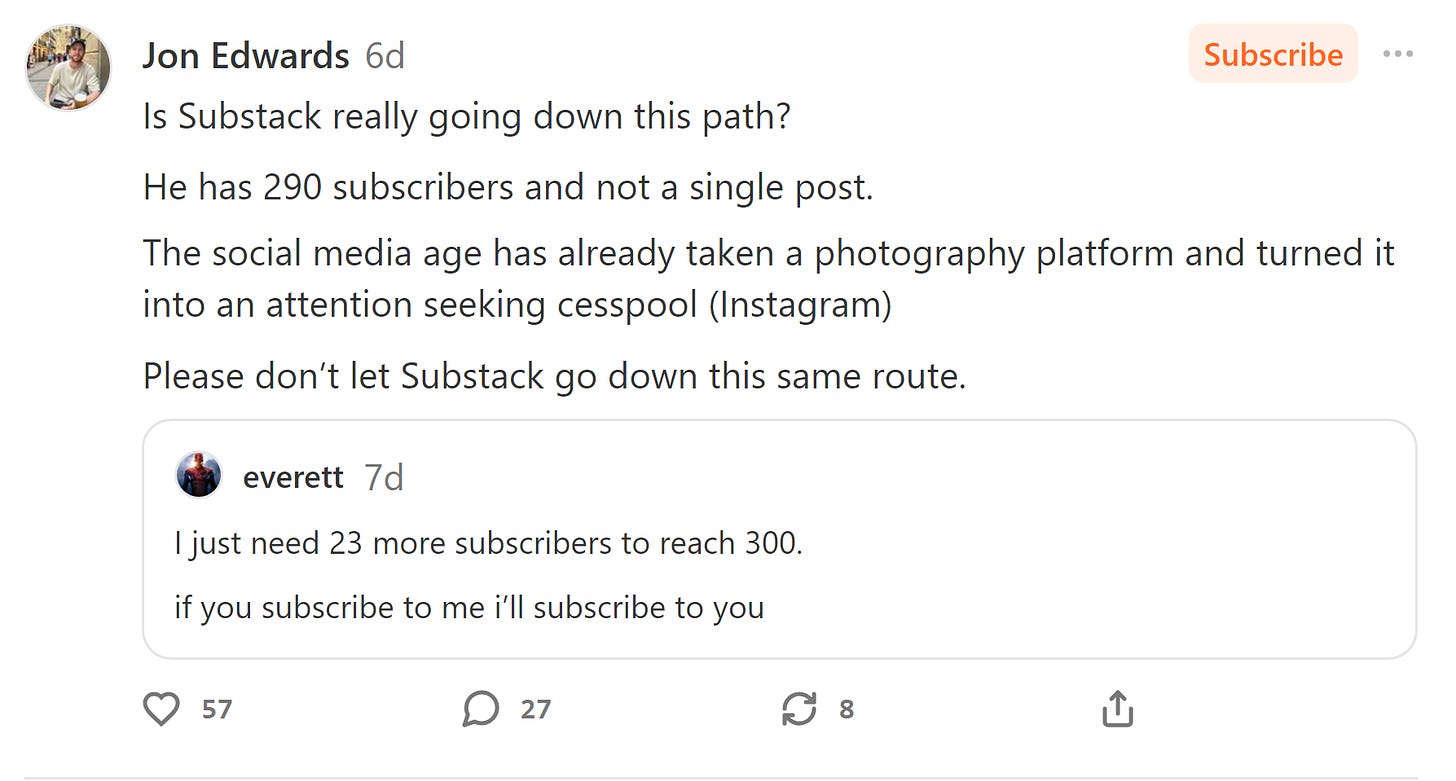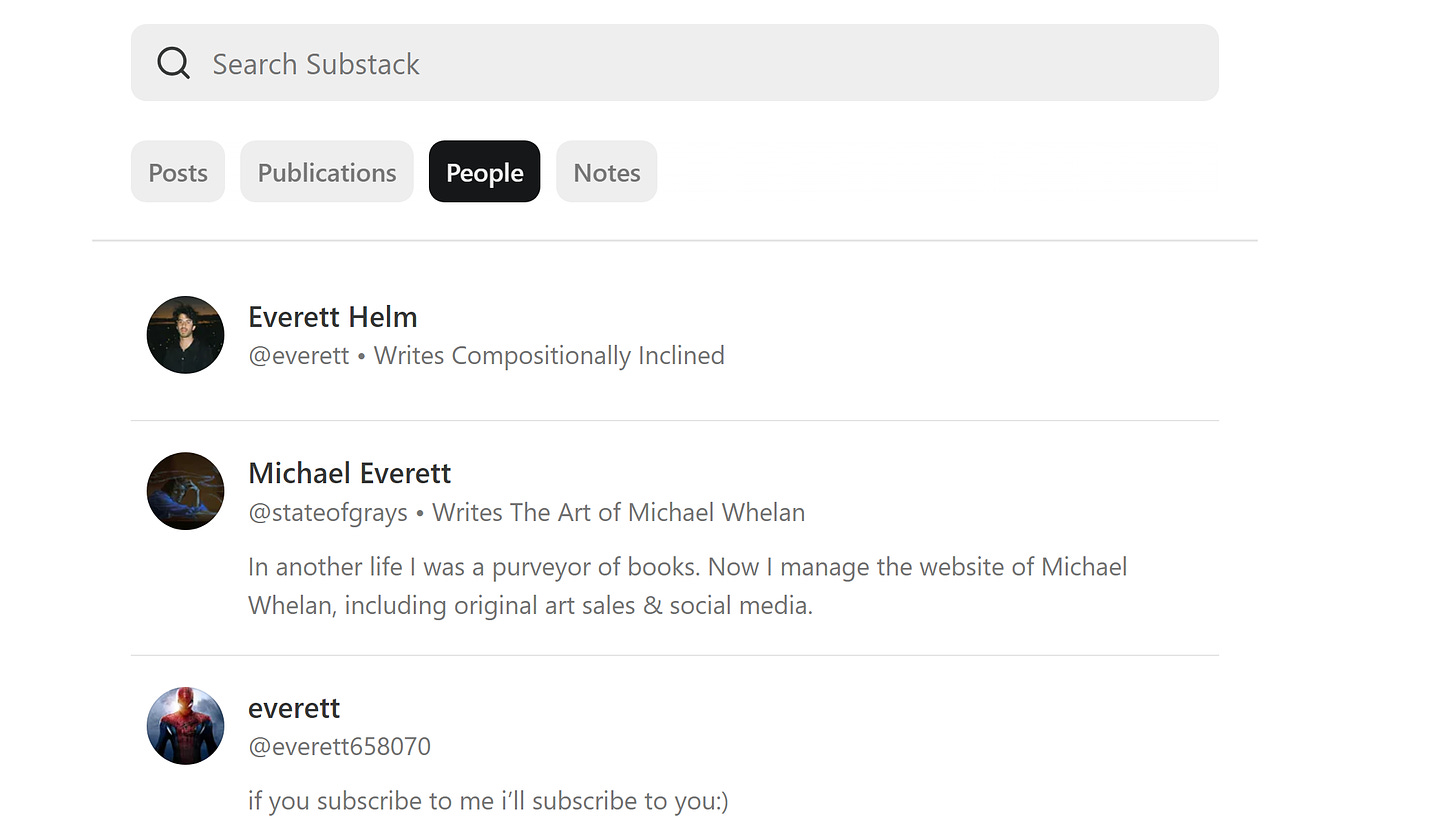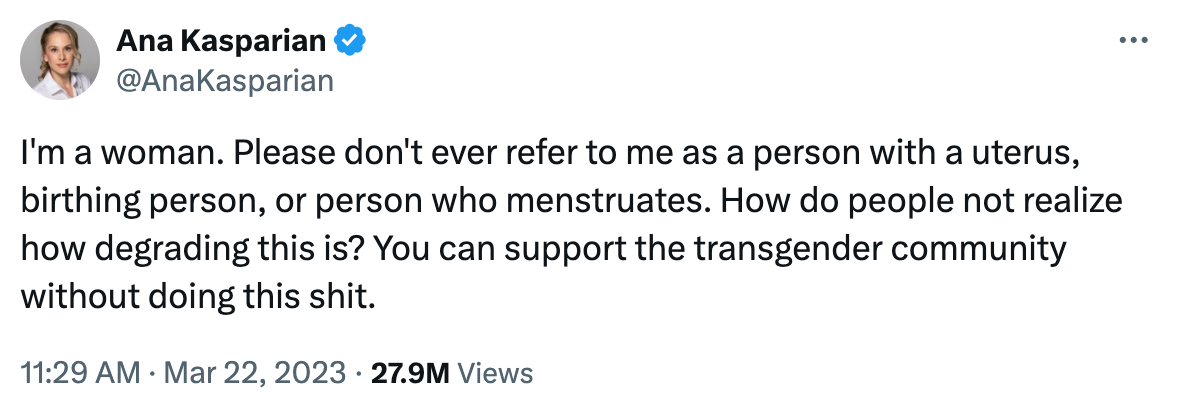The A-Side/"Two Track Substack"
Friday Ramble On - the part of the Substack algorithm that is us
If the innumerable threads are anything to go by, many writers who just want a platform for their work are confused when they fail to get traction on, ‘the home of writing’. Some of you will be reluctant to tolerate what may seem like criticism of Substack, being grateful for what you have gotten from it, but that is not my angle or concern. The chances are that you have participated in similar discussions at some point, only now, the revisionist in you puts it down to a period of self doubt.
Even if you have only read positive things, like tips and tricks on how to grow your Substack, it is because you wanted to know how to get a share of the pie. That is not very much different from someone who, after two years, is wondering why there is no pie left. You might have a visceral objection to the notion it is a zero-sum game and instead insist there is plenty of pie. You may even say that the number of potential readers are, for all practical purposes, unlimited.
That would be a mistake.
At any given time there is a finite number of people available with the potential (due to personal bandwidth and time) to consume your product, but you will only ever get access to a miniscule subset of the potential audience. That should be obvious otherwise we would all be under a deluge of unmanageable content even if it is all relevant to our interests and niches.
It was your early engagement that determined whether or not you got on the fast track to growth. A big influence on that would have been the number of followers you brought with you to Substack. If you got on what I call the slow track you have probably tried to find out why. All the advice for growing your Substack is really a variant on how to switch tracks.
Switching tracks is difficult and the longer you are on the slow track the harder it is because you gradually become invisible. Ultimately, the algorithm is the biggest sharer so if that is not on your side you are, to a great extent screwed until you can change it. Someone can bring followers today can have more traction than you without publishing anything.
Engagement triumphs over content. This could be mistaken for cynicism but it would be more accurate to say that Substack is one of many ‘homes of engagement’. Instagram is not the home of photography and before you even get to monetisation, the thing Substack has in common with it and all the other social media platforms is the currency of validation. It’s what Substack’s social economy runs on.
If we are to be honest with ourselves, growth cannot possibly be about writing, at least not directly. Writing is only one tool of engagement which is why other types of media are being introduced. This is not a complaint but a statement of the obvious and how it all fits together is intuitive once you know what to look for. It’s immediately reconcilable with anything Substack will also tell you.
We can engage with content by critiquing or commenting or we might enter into discussion with the author. Both are examples of measurable engagement. I say this to make you aware, that from here you can assume that when I refer to ‘content’ engagement, I am also referring to how the author of content is engaged. This is valid because the vast majority of the audience will not really distinguish their impression of an author from their content, or if they do, identity will trump the work.
This is why people unsubscribe when they disagree with something they read; they think it tells them something about the author. Of course, the expectation of being able to agree with everything we read or everyone we meet is unreasonable and intellectually craven. The problem is that open-mindedness does not yield validation. Joining coteries, virtue signalling and participating in a ‘pile on’ are rewarded. People self-censor to avoid alienating ‘allies’ and thereby curate their own echo-chamber. None of this is conducive to valuable content or discourse.
Beneath it all Substack social economy is based on validation. identifies an example of where this can lead.
Now it might be that ‘everett’ is just being very shrewd and building up an audience before launch, but what does it say about those who will take this this mutual subscription deal, without knowing anything else about the author or proposed content?
Subscribing to someone who will indiscriminately subscribe back is low cost because it is impossible to get a single subscriber with less effort. It works because at time of writing he is the third hit on the search for ‘everett’ on Substack.
And there are hundreds if not thousands of people with ‘everett’ in their name below that result, most of whom presumably, actually have content. The only value that the algorithm detects, or at least acts upon, is rapid engagement. I would say that this account is on the fast track with zero content and now has more than 550 subscribers because of Notes like this.
This particular Note has garnered more ‘likes’ than all the Notes I have written since May 2023. I have published at least 200,000 words in long-form posts and have triple that in drafts - works in progress, some waiting on information of one sort or another. At the current rate of 6 new free subscribers per month, it would take me 7.5 years to gain the 550 subscribers that everett has accumulated in one month. This algorithm is insensitive to content and the only thing that matters is engagement no matter how it is created.
As I say, we should not infer too much about the account, because this might be just a clever campaign to create a platform for what turns out to be great writing. Nevertheless, it is exploiting a vulnerability that is probably too costly (in terms of platform growth) for Substack to fix.
It is frequently mentioned that Substack are working on improving discoverability and that is what the bot will tell you if you ask about engagement. Yet discoverability is patently under Substack’s control and they can throttle or redistribute exposure, so if there was any intention to improve that for writers it surely could be done quite easily. As I see it, this would involve lowering the engagement threshold for visibility. Without any cynical top-spin I can say there are good reasons for them not to do that.
Having an understanding of those reasons is key to answering the question within this post.
The more general ‘why’ is that it’s done to establish reach on the platform. The underlying reason could be used to generate an audience in advance of launching content, but this is obviously wide open to abuse for those with other agendas, including the spreading of misinformation, ideology or even fraud.
Imagine that you built a huge subscriber base by simply trading free-subscriptions. You’d have a network with a disproportionate number of people who are more gullible and less discerning then average. Perhaps the next step would be to ask them for a trade in paid subscriptions and I will leave it to your imagination as to what might go wrong there.
You see, these are all examples of demand-side models, by which I mean, that they create demand before supplying anything. The reason this works is because it is the unintentional consequence of what Substack wants you to do - bring your own demand/audience. All the algorithm sees is engagement but it can’t recognise whether it has been artificially generated i.e., independent of content. It can be tricked by fake ‘demand’. Crucially, productivity is not factored in, because content is only an indirect means of growing the platform.
More broadly, what Keye describes is what I have previously referred to as, ‘sharing coteries’. It is not only fake accounts but groups of people who generate internal engagement. The major way they do that is by sharing memes since they are ‘engagement efficient’ yielding big returns on low content/effort. They are effectively increasing their validation credit-rating which makes them more visible. So that is how the system can be gamed.
The algorithm is not geared to letting writers have unlimited exposure and this is readily justifiable. They need to give their readers more of what they want and less of what is irrelevant. This breaks down if your followers who have elected to see your content, nevertheless, cannot.
The first thing to realise is that there is so much unconsumed content on the platform that Substack doesn’t need yours, unless you are some kind of influencer. The primary value you offer is the total engagement you bring no matter how you bring it. That engagement can be correlated to the generation of paid subscriptions even if it is not to your newsletter. Therefore ‘celebrity’ writers cannot be allowed to fail because they are far more likely to convert someone to becoming a paid subscriber than you. They are first in line for any exposure and the most likely to paywall.
To summarise that point for the rest of us, the unspoken deal is that you get exposure for bringing people onto the platform, who through sheer weight of numbers could become paying subscribers to something. How you do that might cause you to find a way to game the system.
Substack will even give you tips on how to grow your readership, yet in whatever form the advice comes, it amounts to you generating engagement to prove yourself to the algorithm. Engagement begets exposure and exposure begets engagement. It seems fair enough but what decides your experience of the writing ecosystem is where you sit in the food chain.
My conclusion is that there are two tracks for Substack ‘growth’, fast and slow where slow includes long periods of decay and when there is nothing to deteriorate further, stagnation.
So how to change tracks?
If at this point, you are beginning to think that you would rather read about a success story, you can emulate, I understand. Just realise that really you are seeking the answer to the same question. I am exploring how it works using information and observations that are readily available to you too.
Arms Races
I am fond of discussing arms races because they are everywhere. It is a competition of interests that shows up in evolutionary biology, social systems and international relations where the term comes from. I go further to suggest that arms races are always reducible to technological competitions.
You are probably going to baulk when at my assertion that exposure on a social media platform is a zero-sum game, after all , we have not run out of people to join social media yet. The way to look at it (if only to understand my point) is that at any given time there is a maximum number of people with the potential to be engaged, so let’s call that the ‘attention potential’. A platform must share that potential and for maximum growth it will allocate that exposure to the growing accounts.
One way to game the system is to produce low content with high reach so posts such as memes or sharing posts that from the dominant accounts are a way to gain visibility. Now everything I have said in this piece is entirely consistent with all the advice you will get about growing your publication from Substack. Let me illustrate that by looking at three tips for growing Notes engagement that I got from the Substack bot.
If you're looking to increase engagement with your Notes, here are a few tips:
Engage with other writers: Comment on and share content from other Substack publications to increase visibility.
Optimize your content: Ensure your Notes are concise, engaging, and provide value to your readers.
Promote your Notes: Share them on other social media platforms to drive more traffic to your Substack publication.
These strategies can help you connect more effectively with your audience and potentially increase engagement on your posts.
I will take those in order to show you what I mean.
Commenting on other people’s post increases general visibility is because you are contributing to something that was already visible, after all, you were able to see it. Similarly, if you share something that is already popular, as long as it get’s seen, its engagement-worthiness will translate and the algorithm will pick that up. This is not really about ‘building a community’ as might be interpreted. You increase visibility by leveraging the content of others who already have visibility.
Let’s break that down:
Concise: this is because low informational load propagates more easily and therefore has greater reach.
Engaging: being engaging relates to content and the author - we can say it is how attractive that package is or can be made to appear.
Value: this is clearly not based on informational content because value is measure by engagement only. The dominant value of a found-post to an individual can be broken down into three questions operating at the subliminal level.
How does engaging with this make me look?
How much attention will sharing this bring me?
How will it impact my reach?
So the value-proposition is based on the potential to be validated versus the risk of being ignored. The predominant considerations are whether the person is perceived to be an ‘ally’ on certain topics and the reputational status of the content creator. There are hierarchies for partisanship and identity for which certain people can effectively claim high-status, which includes what I call ‘trauma-trumps’.
This is what Substack incentivises for its own growth i.e., audience outreach and to bring people to the platform. Your internal visibility will be throttled unless you bring in potential subscribers or otherwise find a way to game engagement to improve your social credit-rating. This is because the most influential sharer on Substack is the algorithm itself. You need to drive traffic because the algorithm won’t, at least, not to you. To earn a proportion of that algorithmic attention, you are encouraged to harvest people from other platforms.
It makes a lot of sense that the model is indifferent to the success of writers who are just here to express themselves. To understand that you must think of the value proposition from Substack’s perspective.
Substack recommends you turn on paid subscriptions quickly because that model supports revenue growth. Your readership growth on the platform does not matter because Substack already owns the existing readership traffic. If you come on the platform, grab a share of the attention without monetising, paying for a subscription, or bringing any followers, you are a dead weight as far as Substack is concerned. When you think about it carefully this should not be controversial.
In that economy, validation is very precious, so when tweeted something that would have been almost universally perceived as reasonable only a few years ago, it was an opportunity too good to miss for some.
She commented:
All hell broke loose after I posted those words. Most “friends” in left-wing media didn’t bother reaching out privately to discuss their disagreement with my personal preference. Instead, many self-described socialists took it upon themselves to profit from conflict by publicly attacking me with monetized videos.
Independent and Unaligned, Unaligned (Substack), Anna Kasparian
This happened is because this was an opportunity to virtue signal and haul in massive heaps of validation. The value of this, which extends beyond immediate monetisation, is also apparently more important than personal friendships. This is a zero-sum game. There is always someone bearing the cost and this was the equivalent of robbing her. The famous Shakespeare lines below express a sentiment that has been true for centuries.
Who steals my purse steals trash. ’Tis something, nothing:
’Twas mine, ’tis his, and has been slave to thousands.
But he that filches from me my good name
Robs me of that which not enriches him
And makes me poor indeed.
“Orthello”, Scene III (Iago), William Shakespeare
Only it’s no longer is true in some contexts. Filching a person’s reputation is now potentially enriching and perhaps the monetisation of other people’s downfall is one of the most egregious aspects of social media.
The Evolution of Opportunity
That is not to say there is not an opportunity for writers to get an audience with long-form content from scratch, because there evidently is, but it will be typically slow track with long periods of stagnancy until you make a breakthrough, most likely on Notes. Now you might be discovered quickly by an influencer but it is not likely enough to bank on. Unchecked I believe the platform will change in ways that are not generally anticipated due to the how the arms race has been set up.
I anticipate the following trends will take hold.
Long-form content dominated by large celebrity accounts.
Proliferators of short-form content such as memes on Notes and restacks.
Engagement gamers.
Celebrity accounts will engage exclusively with the most active paid subscribers. In fact it will be against their interests to engage with non-paid subscribers for two reasons:
Their paid subscribers are likely to resent it and may downgrade to free.
Validation is zero-sum. The larger accounts won’t waste their time and engaging with a ‘nobodies’ because -
they don’t want to be too accessible which gives the wrong impression and potentially opens them up to spam.
there is an opportunity cost of not engaging with an influential account instead.
the reputational risk of both engaging and being seen to readily engage with the hoi polloi.
To conclude. The Substack algorithm only discriminates on the basis of engagement and from that everything else flows. Engaging with dopamine hitting doom-scrolling is more addictive than reading long-form content. At the bottom of the content caste-system will be masses of impoverished disposable content competing for attention with an elite class of long-form producers.
Engagement is ultimately determined by the dynamics of bias, validation and how content is valued. All the discrimination comes from the biodegradable side of the algorithm that is us.
Next Friday’s ramble:
The B-Side/“The Two Tracks of Your Tears”, The Vigne Intervention









V interesting read – lots of ideas to digest here. And I'd never thought of this: "If you come on the platform, grab a share of the attention without monetising, paying for a subscription, or bringing any followers, you are a dead weight as far as Substack is concerned." As you say, it's obvious when you think about it!